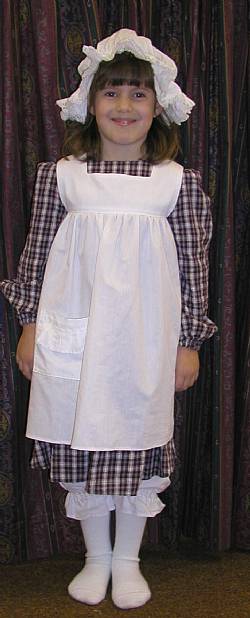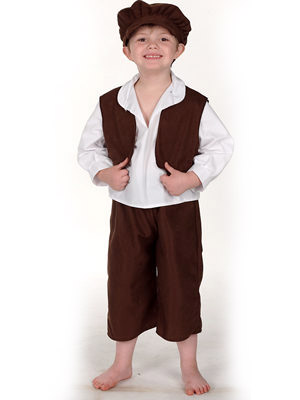“The clothes make the man” is a phrase that probably could have been penned during the Victorian period. Victorian clothes were very much a symbol of the status and standard of living of the person. Children in the Victorian era usually wore huge bulky clothes to reveal the status of their parents and family.
The concept of sewing machines emerged only towards the end of the Victorian era. Until then there was no way at all of making cheap clothes. Most wealthy and middle-class children wore exquisite dresses designed by a dressmaker, unlike the poor children who wore tatty clothes and rags which were often discarded by the rich people and were handed down to the poor class.

The upper class wore rich tailor-made suits or frocks which were worn by them until they were beginning to show little traces of dirt. Then they were discarded as the fine outer garments could not be washed without spoiling them. Other clothes when showed signs of wear were discarded and then passed on to the poor class.
The discarded clothes were usually given to the servants, who wore them until they reached the next stage of decay and then the poor class would sell them to the street urchin who would wear clothes which were of no value. Good second-hand clothes commanded quite high prices.

The dresses and clothes of baby boys and girls were quite similar for most of the Victorian period. The royal families were fashion setters such as sailor suits and tartan. Children’s clothing was very similar to the adult dresses. There was a gradual decline in the practice of dressing children in adult styles during the second half of the 19th century.
The Victorian-era boys would have white linen shirts with huge bows about the necks and velvet breeches that fitted at the knees. The huge sailor collars for both boy’s and girl’s clothing came into fashion during the Victorian period. Cotton or silk stockings were worn which would cover the lower legs.
The shoes of the children were made of fine leather with ornate buckles. The well-dressed Victorian boys would also wear broad-brimmed straw hats with decorations of ribbons. Long curls were quite popular for boys during the Victorian times. The common style was the pageboy cuts just above the shoulder.
Little girls who lived during the Victorian times wore starched and pressed pinafores and their hair would be curled and styled to perfection without any fault. They would wear cotton or silk stockings to cover their legs and their shoes would be made of soft leathers or beautiful fabrics that matched their dresses.
The peculiar style of the dresses was dropped waists and huge bows that tied in the back. These were commonly made with huge sailor-style collars with bows at the center. For some of the more formal dresses, miniature bustles were made in a similar style to the women’s fashion of the day.
Victorian era clothing, with its intricate details and formal styles, is often romanticized in modern culture. Children’s clothing of the time, much like that of adults, was indicative of social status, age, and occasion. Here’s a dive into the prevalent styles and conventions associated with children’s fashion during this period:
Influences and Materials The Victorian era was marked by the Industrial Revolution, which brought about significant changes in textile production. New materials became available, and advancements in dyeing techniques introduced a variety of colors. However, natural fibers like wool, cotton, and silk dominated children’s clothing.
Infant Clothing Infants, irrespective of gender, were typically dressed in long white gowns known as christening or baptismal gowns for their first few months. These gowns were often elaborate, adorned with lace and embroidery, and could be handed down through generations.
Breeching One of the most significant rites of passage for a young Victorian boy was “breeching” – transitioning from wearing gowns or dresses (common for toddlers regardless of gender) to wearing trousers or breeches. This usually happened between ages 4 and 7, symbolizing a step towards boyhood and away from the infancy and neutrality of the gown.
Girls’ Clothing As girls grew older, their dresses became longer, progressing from the short frocks of early childhood to ankle-length dresses in adolescence. Dresses were often layered with petticoats and accessorized with sashes, bows, and ruffles. Pinafores, protective aprons worn over dresses, were common for everyday wear, especially for play or chores.
Boys’ Clothing After breeching, boys wore shorts or knickerbockers with stockings until they reached the age of puberty. From then, they transitioned to long trousers. Waistcoats, jackets, and hats were also staples of a young boy’s wardrobe, reflecting the style of adult men’s clothing.
Footwear Children commonly wore boots, which were buttoned or laced. For girls, ankle-length boots were standard, while boys might wear higher boots. In the later Victorian period, shoes with straps, known as Mary Janes, became popular for girls.
Hair and Accessories Girls often wore their hair in curls, braids, or pulled back with ribbons. Boys typically had short hair, but it wasn’t unusual for them to sport ringlets when they were very young. Accessories like bonnets for girls and caps for boys were also integral parts of children’s attire, providing protection from the elements and adding to the overall look.
Formal vs. Play Clothes Just like adults, children had different sets of clothing for various occasions. While they might wear elaborate and restrictive clothing for formal events, play clothes were simpler and allowed for greater movement.
Societal Class and Clothing It’s important to note that while the aforementioned styles were prevalent, they were more accessible to the middle and upper classes. Working-class children wore simpler, more durable clothing, often handed down from older siblings or even adults.
In conclusion, children’s clothing in the Victorian era was a blend of function, societal norms, and burgeoning fashion trends. While it often mirrored adult styles and was influenced by societal status, it also had unique features that differentiated the world of children’s fashion from that of their grown-up counterparts.